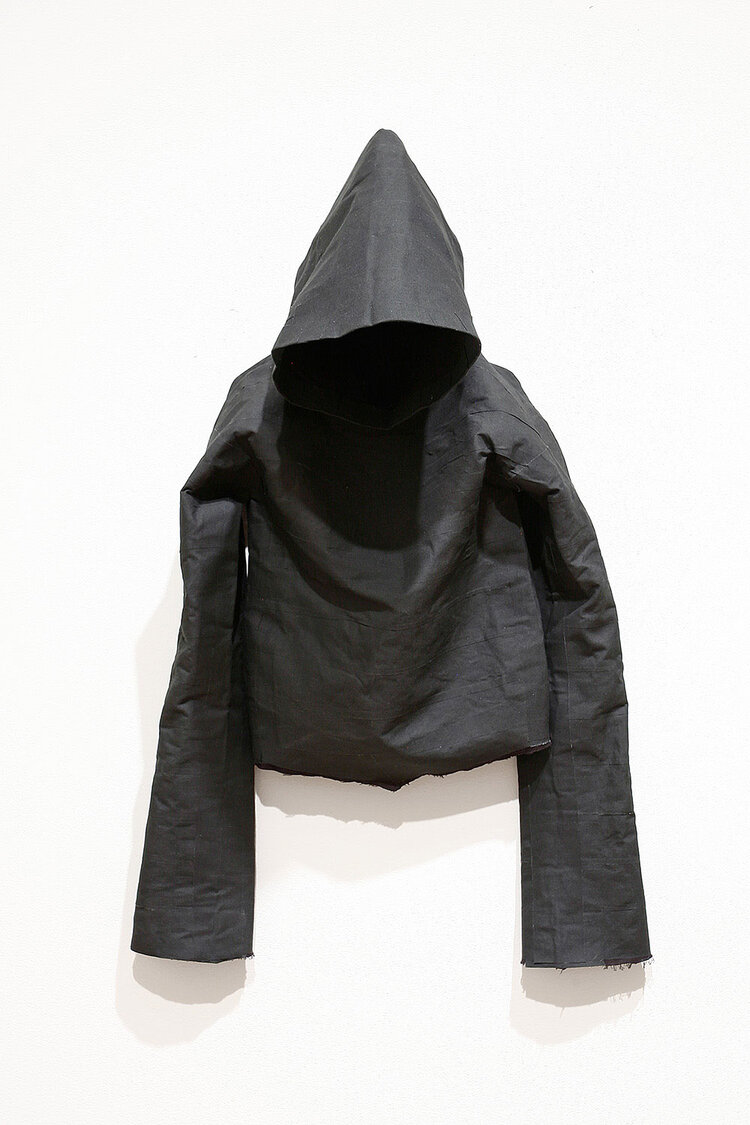Collection Connection is a series of personal responses by museum staff to works in the Frye Art Museum’s collection.

Mark Calderon. Untitled, 2012. Book spine repair tape. 30 x 20 x 12 in. Frye Art Museum, Museum Purchase with funds provided by Ann P. Wyckoff and Theiline P. Scheumann, 2013.012. Photo: Mark Woods
Over the past few days—amid the mounting outrage and rushing streams of images and videos calling for justice in the wake of the deaths of George Floyd, Breonna Taylor, Ahmaud Arbery, Tony McDade, and countless others—Mark Calderon’s Untitled resurfaced in my mind. It is an artwork that serves as yet another reminder of how little has changed over the past decade in relation to anti-black violence and policing in the United States. Calderon’s piece takes the shape of a hollow garment immediately reminiscent of a hoodie sweatshirt. The work is constructed out of a particular kind of tape used to repair the broken spines of books, called filmoplast T. The use of this material coupled with the sculpture’s empty form evokes a deep sense of loss and an attempt to attend to that loss. While Untitled offers itself up to multiple interpretations, Calderon made the piece in the wake of the shooting of seventeen-year-old Trayvon Martin in 2012, and it brings that particular tragedy to the fore.
Untitled closely recalls David Hammons’ incisive work In the Hood, in which Hammons lined a torn-off sweatshirt hood with wire to create a hollow space for an absent face and nailed it to a wall. While Hammons’ piece was made in 1993, nearly twenty years before Calderon’s, it has become an iconic image in the aftermath of Trayvon Martin’s murder and a symbol of the Black Lives Matter Movement. In particular, the artwork has become emblematic of the effort to combat the notion that a Black person wearing a hoodie is a trigger for projected racial fear and suspicion.
Importantly, in both Calderon’s and Hammons’ pieces, there is no figure, only the presence of negative space inside the hood. The absence of a body not only lends each work its multivalent yet concise power, but also acts as a refusal of representation. Decades of gruesome footage of police brutality spread across mass media has repeatedly failed to bring justice and lasting change. As artist Danny Giles writes of Hammons’ work, among others, “By redacting the object of white violence, these works redirect our attention to the cultural and social systems that police the boundaries of race and class.” These oppressive systems thus become the subject of works like Untitled and In the Hood, where attending to the loss each piece evokes becomes the ongoing daily work of dismantling the racist ideologies and oppressive structures that created the loss in the very first place.
For some further reading, I suggest MONDAY, an arts journal published by the Jacob Lawrence Gallery at the University of Washington, specifically the fourth and most recent volume guest-edited by artist Danny Giles; and the various readers (available both in print and digital format) published by Cassandra Press, run by artist Kandis Williams and philosopher Taylor Doran.
David Strand
Associate Curator